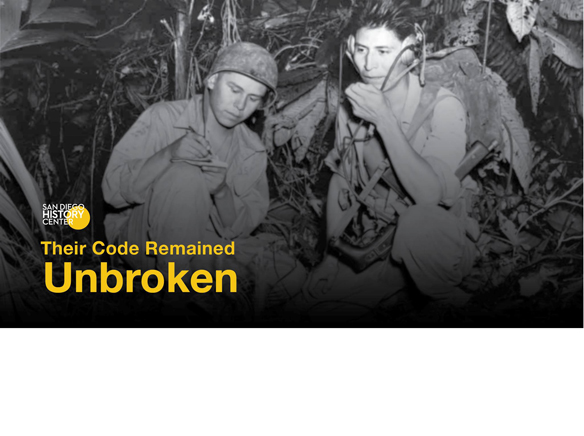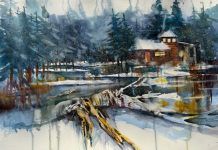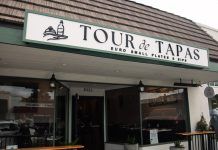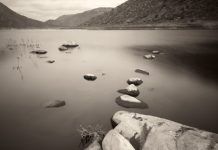It’s a story of the horrors of war, protecting a way of life, a culture, a peoples land, and of healing of the people of the Navajo Nation that played a prominent role in defeating the Japanese in World War II. It’s also a work of history of the Navajo men that volunteered their service in a way that has significant historical value. This is the 15-year journey through history, created by Dr. George A. Colburn, tells the untold story of the Navajo Code talkers through a moving educational documentary.
It’s a story of the horrors of war, protecting a way of life, a culture, a peoples land, and of healing of the people of the Navajo Nation that played a prominent role in defeating the Japanese in World War II. It’s also a work of history of the Navajo men that volunteered their service in a way that has significant historical value. This is the 15-year journey through history, created by Dr. George A. Colburn, tells the untold story of the Navajo Code talkers through a moving educational documentary. Colburn, writer, director and producer of “Navajo Code Talkers: A Journey of Remembrance” documented the stories of six surviving Code Talkers, talking to them in their homes in the Navajo Nation in the American Southwest, USMC Camp Pendleton, where they learned the code and trained and taking these six survivors along with family members back to Guam, Saipan, Tinian, Iwo Jima and Okinawa. It’s San Diego premier was held at the San Diego History Center on Nov. 8.
This was no small feat for Colburn, as none of the survivors wanted to return to these places. After the war, they were told by their spiritual leaders not to talk about the war and also to never return to the land where they battled their enemies. They and their families tell the stories of the inner demons that they faced, especially within their own families as the spiritual leaders and the government both silenced them from speaking about their part in the war.
Emotionally charged, six Navajo Code Talkers told their stories to Colburn that ranged from their ancestral history, the reasons they joined the war after the bombing of Pearl Harbor, the devastation they witnessed, and their code of silence that lasted many years after the war was over. Only six decided to take this journey, and as of today only two of the six are living. But from the words of Keith Little, Samuel Sandoval, Albert Smith, Samuel Jesse Smith, Samuel Tso and Teddy Draper, all Navajo Code Talkers, this documentary brings history to life and reveals the integrity and love they had for their people, culture and land.
Leapfrogging, commonly known as island hopping was a strategic military strategy used by the United States during World War II in gaining and securing small Pacific islands in the Pacific. These islands were not as strongly defended by the Japanese and gave the U.S. an advantage, and this campaign that took the military to Tarawa, Saipan, Guam, Tinian, Iwo Jima and Okinawa. This campaign created some of the most brutal and bloody battles in U.S. history, but its success was prominent in the final surrender of the Japanese and Axis powers during the War. A large part of these victories came with the help of the Navajo nation of people that became known at the Navajo Code Talkers. Navajo language is not written or read, so the creation of a code through the use of this language proved to be a powerful tool in overcoming the Japanese, as this code was never broken, giving the U.S. a strong strategic advantage. It worked so well, that this code remained silent until 1968 when the Navajo Code was declassified. In 1982, president Ronald Reagan declared August 14, “Navajo Code Talker Day” and it wasn’t until 2000 that president Bill Clinton awarded the Congressional Gold Medal to the original 29 Code Talkers.
There are so many poignant moments in this documentary it is impossible to cover them all. Not wanting to return to places that they saw only death and devastation, this journey proved to be more than just recording history, it brought peace and healing to these six Code Talkers, and U.S. marine riflemen. These Native American heroes did not join the war for the sake of the country, but for the sake of their people and their land. It wasn’t until this was all over that many realized that their land included the American way of life as a whole and that their role in this war made an indelible mark in our history.
As these soldiers returned to the islands that they helped invade and secure from the Japanese, all of them were in wonder of what they saw, so much so that it changed their lives forever. Remembering charred battlegrounds, demolished lands and cultures being swept away by war, returning brought a healing that none of them expected. Seeing the islands in a new light, green with growth, people that were thankful for their part in preserving their own cultures, they realized that their role was more than just defeating the Japanese. It was preserving freedom, cultures and a way of life that is flourishing today as a result of the island hopping campaign.
Through personal interviews with the six Code Talkers and their families, this documentary sheds light to more than historical facts, but the heart of the Navajo people, and for the Code Talkers, their undisputable role in victory.
Colburn created this one-hour film for educational purposes and is still working on the film to bring it to television. Through his speaking and film engagements, he is raising money, at $15 for each sale of the documentary to get this film into the educational system throughout the U.S. in electronic form so that students across the nation have access. As a historian, professor and producer, education is at the forefront of his cause. There is no better way to learn the history of an event such as this as this documentary does with the personal testimonies of those that lived through it.
“A Journey to Remember” will take you on a rollercoaster ride of emotions as you walk with these Navajo war heroes from the history of their people in America and their journey through war, peace, restoration and hope for a better future for all Americans.
For more information about this stunning documentary, to see how you can get a copy of the documentary and get a glimpse of what this documentary offers to education in our society, visit www.georgecolburn.com and www.starbrightmediacorp.com.
The San Diego History Center was a spectacular venue for this event, with remarkable exhibitions, this is a must go to for those that have the love of history through arts, located in the heart of the El Prado in Balboa Park. For more information on what the San Diego History Center is now offering to the public, visit www.sandiegohistory.org.















Can you! need something
Can you! need something startup new? Take a look at this website. Only there the choice of slaves for every taste and completely free! They are good slaves, they will do anything you command !
http://gov.shortcm.li/kings#C4